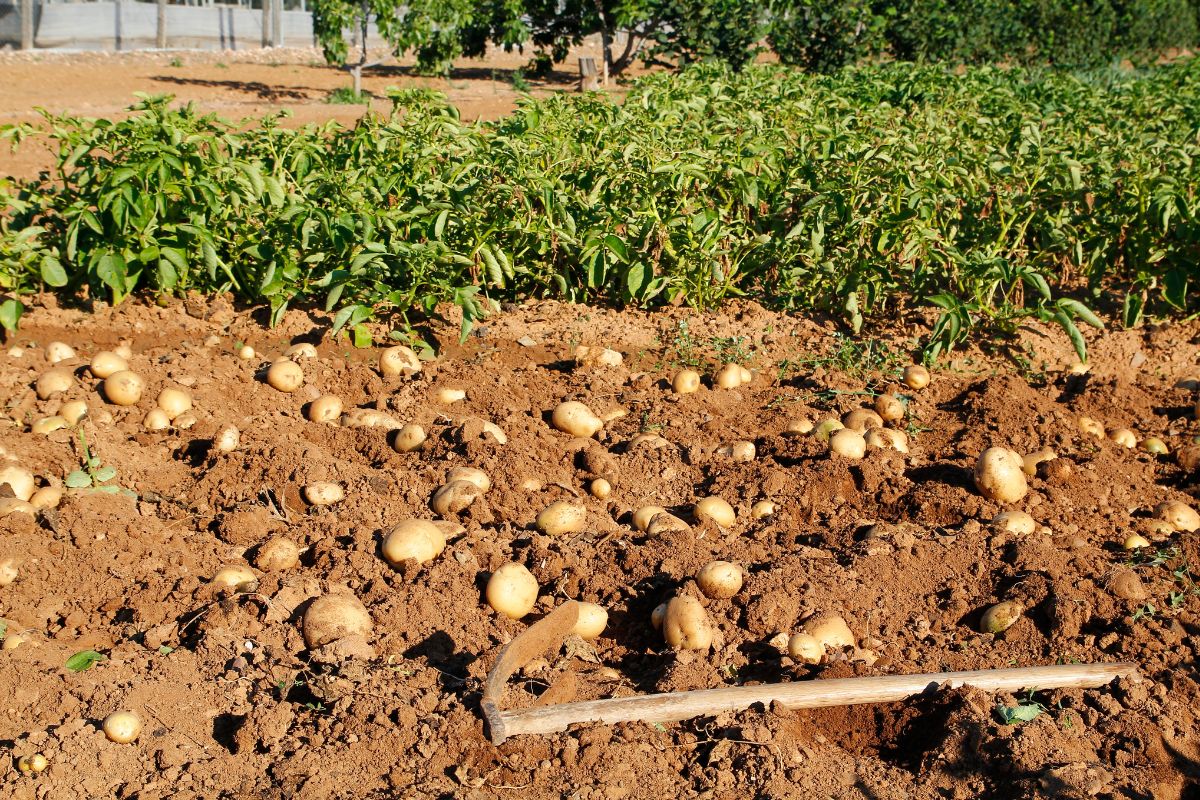Harvesting potatoes is a rewarding experience that marks the culmination of months of patience and care. Whether you’re a seasoned gardener or trying your hand at growing potatoes for the first time, knowing when and how to harvest these versatile tubers ensures you’ll enjoy the best quality and flavor. The process requires attention to timing, proper techniques, and post-harvest handling to maximize your yield.
When to harvest your potatoes
Timing is crucial when it comes to harvesting potatoes. The ideal harvest period depends on the potato variety and your intended use. Generally, potatoes take between 70-120 days to mature after planting, but several indicators can help you determine the perfect moment.
For new potatoes – those small, tender gems with thin skins – harvest can begin about two to three weeks after the plants have flowered. These early potatoes don’t store well but offer a delicate flavor perfect for summer meals.
For storage potatoes, patience pays off. Wait until the plant foliage begins yellowing and dying back naturally. This signals that the plants have transferred their energy to the tubers underground. A good rule of thumb is to wait 2-3 weeks after the foliage has completely died back before harvesting.
Watch for these clear signs that harvest time is approaching:
- Yellowing and browning of plant foliage
- Dried stems that fall over easily
- Thickened potato skins that don’t rub off easily
- Flowers have bloomed and faded
If you’re growing potatoes in regions with early frost, harvest before the first freeze. Frozen soil can damage tubers and make harvesting significantly more difficult. Similarly, avoid harvesting during extremely wet conditions, as soggy soil can lead to hollow heart in potatoes, a condition where the center becomes hollow due to stress during growth.
Tools and techniques for potato harvesting
Harvesting potatoes requires careful extraction to avoid damaging the tubers. The right tools and techniques can make this process more efficient and help preserve your crop’s quality.
Before you begin, gather these essential tools:
- Garden fork or potato fork (preferred over shovels as they’re less likely to slice tubers)
- Garden gloves to protect your hands
- Containers for collecting harvested potatoes (breathable baskets or crates work best)
- Pruning shears to cut away stubborn vines
When you’re ready to harvest, start by cutting back any remaining foliage to ground level if it hasn’t already died back. This step makes accessing the soil easier and prevents the vines from getting tangled in your tools.
Position your garden fork about 12 inches away from the plant stem. This distance helps avoid piercing the hidden potatoes clustered around the main plant. Insert the fork deeply and gently lift the soil, loosening it around the plant. Work in a circle around each plant, gradually lifting more soil until the potatoes become visible.
For container-grown potatoes, simply tip the container on its side and gently dump the contents. This method often results in less damage to the tubers and makes collection easier. Growing potatoes alongside other root vegetables like radishes or turnips in your garden can maximize your harvest space and provide a variety of root vegetables with similar growing conditions.
Once the soil is loosened, use your hands to carefully search through the dirt for potatoes. Be thorough – small potatoes are easily missed but just as delicious. Handle each potato gently, as their skins are susceptible to bruising and punctures that can reduce storage life.
Post-harvest handling and storage
The way you handle potatoes immediately after harvest significantly impacts their longevity and quality. Proper curing and storage techniques preserve flavor and prevent spoilage.
After collecting your potatoes, gently brush off excess soil instead of washing them. Freshly harvested potatoes have delicate skins that can be damaged by scrubbing, and moisture promotes rot. If you must clean heavily soiled potatoes, use a soft brush and allow them to dry completely before storage.
Curing is essential for storage potatoes. This process toughens the skin and extends shelf life. Spread your harvest in a single layer in a dark, well-ventilated area with high humidity (85-90%) and moderate temperatures (60-65°F) for 1-2 weeks. During curing, minor cuts heal and the skins set, creating a protective barrier against bacteria and moisture loss.
After curing, inspect each potato carefully. Any tubers with cuts, bruises, or signs of disease should be set aside for immediate use rather than storage. These imperfect specimens make excellent additions to vegetarian casseroles or can be paired with other root vegetables like beets for hearty roasted vegetable medleys.
For long-term storage, place sound potatoes in breathable containers like paper bags, cardboard boxes, or wooden crates. Never use plastic bags, which trap moisture and accelerate spoilage. Store in a cool (38-45°F), dark, and moderately humid location. A dedicated root cellar is ideal, but an unheated basement or garage can work in many climates.
Check stored potatoes regularly and remove any showing signs of sprouting or softening. With proper storage, many potato varieties will keep for 4-6 months, providing you with homegrown produce well into winter.
Maximizing your potato harvest
To get the most from your potato-growing efforts, implement strategies that increase yields and enhance tuber quality from planting through harvest.
Start with certified disease-free seed potatoes to avoid introducing problems into your garden. Proper spacing during planting (about 12-15 inches between plants) allows each plant adequate resources while maximizing garden space.
Throughout the growing season, hill your potatoes by mounding soil around the stems as they grow. This technique increases the underground stem area where tubers form and prevents greening from sun exposure. Some gardeners combine potatoes with summer squash varieties in their garden planning, as the sprawling squash plants can provide ground cover that helps maintain soil moisture for potatoes.
Rotate your potato crop location each year to prevent soil-borne disease buildup. A four-year rotation is ideal, meaning potatoes shouldn’t return to the same spot for at least three growing seasons.
If you’re growing multiple potato varieties, keep records of their performance. Note which varieties store best, which produce highest yields, and which have the flavor profiles you prefer. This information becomes invaluable for planning future potato gardens tailored to your specific growing conditions and culinary preferences.
With these harvesting techniques and storage practices, you’ll maximize both the quantity and quality of your homegrown potato crop, enjoying the fruits of your labor long after the growing season has ended.

